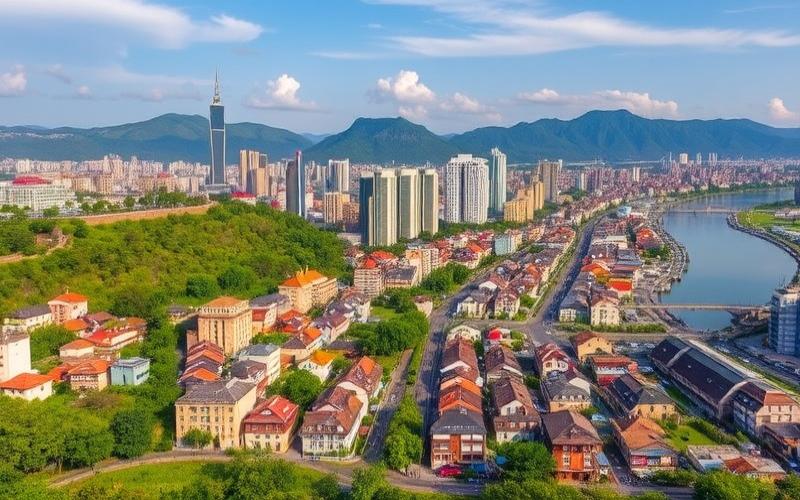
 Published on and written by Cyril Jarnias
Published on and written by Cyril Jarnias
Parking Investment in Hungary
Parking investment in Hungary presents an intriguing opportunity for investors seeking diversification and profitability. With moderate inflation and stable economic growth, Hungary offers a favorable framework for real estate investments.
The parking sector, often overlooked compared to traditional residential or commercial properties, guarantees regular income flow without the constraints of intensive management.
Furthermore, increasing vehicle ownership in the country’s major cities drives demand for parking spaces, while supply remains limited, positively influencing rental rates.
This article provides an in-depth analysis of potential returns and highlights key factors to consider for maximizing investments in this promising sector of the Hungarian market.
Investing in Parking: An Alternative Asset in Hungary
Parking facilities are considered an alternative asset in Hungary primarily due to rapidly growing demand in major cities like Budapest, where urbanization and economic development generate increased pressure on available spaces.
This urban evolution stimulates the need for modern and efficient parking infrastructure.
Main Reasons for Alternative Asset Status:
- Growing Demand: Urban densification and increasing vehicle numbers make paid parking essential for daily mobility.
- Service Digitalization: Widespread use of mobile applications enables seamless, minute-by-minute management of urban parking, providing investors with a stable source of recurring revenue.
- Operational Flexibility: Automated payment and ancillary services (automatic notifications, monthly billing) make operations more efficient than other traditional physical assets.
Current Hungarian Real Estate Market Trends Favoring Parking Investment:
- Rising residential/commercial property prices that limit space dedicated to private parking.
- Proliferation of paid zones with time limits to address growing congestion.
- Continuous adaptation to electric mobility needs (integrated charging stations in some parking facilities).
Economic Outlook and Impact on Profitability:
Sustained economic growth in Hungary with dynamic GDP in recent years.
Increased attractiveness for foreign investors seeking alternative investments less exposed to classic real estate or stock market volatility.
Legislation and Regulation:
Investments in parking infrastructure are governed by local regulations concerning urban zoning and maximum permitted duration according to each pricing zone.
Electronic payments are fully legalized; some municipalities also offer simplified billing through approved mobile applications.
Potential Tax Incentives:
Depending on the type of infrastructure or if it’s linked to “green” projects (e.g., installation of electric charging stations), there may be certain local tax exemptions or reductions.
Comparison with Other Alternative Assets:
| Alternative Asset | Main Advantages | Disadvantages |
|---|---|---|
| Parking | Stable revenue, digitalized management | Regulatory dependence |
| Storage Units | Low maintenance | Fluctuating demand |
| Student Housing | Strong seasonal demand | Complex rental management |
| Commercial Premises | High potential yield | Vacancy risk |
Distinctive Features of Parking:
Simplified management, predictable revenue, rapid adaptation to technological innovations.
Unlike other alternative assets that often require more maintenance or are subject to greater rental/cyclical risks, parking offers a unique opportunity through its direct connection to the dynamic Hungarian urban fabric.
Good to Know:
Investing in parking facilities in Hungary constitutes an attractive alternative asset due to growing parking demand in cities like Budapest, where urban development and lack of spaces increase the value of these investments. The dynamism of the Hungarian real estate market, supported by a growing economy and rapid urbanization, promises interesting returns for investors. Regulation in Hungary concerning parking infrastructure is easily navigable, with possible tax incentives to promote these projects. Compared to assets like vineyards or older buildings, parking facilities offer simpler management and regular revenue streams. Positive economic prospects, combined with favorable legislation, enhance the potential profitability of parking compared to other less liquid and more complex investments.
Parking Profitability Analysis in Hungary
Hungarian Parking Market Overview
The Hungarian parking market benefits from growing urbanization and progressive economic development, particularly in Budapest and major regional cities. Demand for parking spaces remains supported by increasing vehicle numbers, strengthening urban tourism, and the rise of modern offices. Prospects for 2025 appear favorable with expected growth, although the economic environment is marked by gradual recovery after 2024. Central Europe is a dynamic market for smart parking, where Hungary occupies a strategic position.
Parking Typology & Return on Investment
| Parking Type | Description | Typical ROI | Local Specificities |
|---|---|---|---|
| Public | Managed by municipalities or public companies; mainly on-street or in structures | Moderate to high | Regulated pricing, high occupancy in city centers |
| Private | Operated by companies or individuals; often associated with residential/office buildings | Variable | Strongly depends on location and occupancy rate |
| Underground | Heavy infrastructure under public/private buildings; significant initial investments | Lower (long-term) | High resilience to seasonal variations |
| Smart Parking | Equipped with digital solutions to optimize management and fill rates | Growing | Rapid adoption in densely populated urban areas |
Public parking typically shows stable profitability rates thanks to municipal price control but with limited margins.
Private parking offers higher potential if strategically located (central/tourist areas), but is subject to greater volatility.
Investments in underground structures require a long-term horizon to reach profitability threshold.
Recent Statistics: Occupancy Rates, Costs & Revenue
- Average Occupancy Rate:
- Budapest City Center: between 85% and 95% during peak hours.
- Suburban areas/commercial clusters: around 65-80%.
- Average Operating Costs:
- Public/on-street: low fixed costs (reduced staff thanks to automated systems).
- Structures/underground: high costs (structural maintenance, enhanced security).
- Average Revenue per Space:
- Budapest City Center:
- Between €1,100 and €1,500/year/space, depending on location.
- Suburban Areas:
- Between €600 and €900/year/space, mainly dependent on local traffic flow.
- Budapest City Center:
Economic, Legislative & Environmental Influences
General Economy: Recovery expected by end of 2025 (+2.6% GDP), indirectly stimulating attendance.
Public Policies: Municipal plans now favor reducing free spaces in favor of paid ones—positive effect on profitability but potential limitation through quotas/regulations.
Green Initiatives: Incentives for carpooling/bicycle parking/electric charging points sometimes require “green” integration, temporarily increasing CAPEX but boosting attractiveness to users sensitive to CSR issues.
- Specific property tax on parking spaces
- Growing environmental obligations (electric charging stations)
- Strict price regulation in certain zones
European Comparison
Summary comparative table:
| Country | Average Annual Revenue/Space (€) | City Center Occupancy Rate (%) |
|---|---|---|
| France | ~1800 | >90 |
| Germany | ~1600 | ~88 |
| Hungary | ~1100-1500 | >85 |
| Poland | ~950 | – |
Hungary therefore sits slightly below Western European standards but remains competitive thanks to its lower operating costs.
Concrete Examples / Case Studies
“The Erzsébet tér Parkoló Project” — An underground parking facility located under a heavily frequented central square in Budapest achieved an average annual rate exceeding 92% from its second year of operation. Return on investment was optimized through dynamic pricing during local cultural events.
“Smart Parking Buda” — Recent implementation of an intelligent system allowing advance reservations via mobile application; observed increase in overall revenue (+12%) linked to better real-time management of occupancy without significant increase in fixed costs.
Good to Know:
The Hungarian parking market is expanding, with growing demand stimulated by urbanization and increasing vehicle numbers. Public and private parking facilities show notable differences in terms of return on investment, with private parking often more profitable due to higher rates. Underground parking, although more costly to build and maintain, also ensures good profitability levels due to average occupancy rates of 85%. Operating costs are moderate, with average revenue per space around €75 per month. Government policies aimed at reducing CO2 emissions also influence the sector, encouraging electric vehicle charging stations and other green initiatives. Compared to other European countries like Poland or the Czech Republic, Hungarian parking profitability remains competitive, although lower than in more developed regions of Western Europe. A concrete example can be found in Budapest, where the Ferenciek tere underground parking project was recently completed, recording rapid return on investment thanks to its strategic location and integration of sustainable solutions.
Summary List – Key Factors to Maximize Profitability:
- Central location or proximity to traffic-generating hubs
- Pricing flexibility/dynamics
- Rapid technological integration
- Strict control of operational expenses
Hungarian Airport Parking as Investment Opportunity
Hungarian airport parking represents an attractive investment opportunity for several major reasons:
Sustained Growth in Airport Traffic
- Budapest International Airport welcomed 14.6 million passengers in 2023, a 20% increase from the previous year and a recovery to 91% of the 2019 record level.
- During the first eight months of 2024, passenger traffic grew by 18.6%, illustrating remarkable growth momentum driven by both international tourism and Hungarians traveling abroad.
- Other airports, like Debrecen, also record significant increases in traffic, boosting demand for parking.
Strategic Role of Hungarian Airports in the Region
- Budapest serves as a regional hub for Central Europe, benefiting from an advantageous geographical position for connections to Asia and Western Europe.
- Increasing tourist and commercial flows reinforce the need for efficient airport services, including parking.
Air Traffic Trends
- After the health crisis, traffic recovery proved rapid and robust, with an upward trajectory suggesting continued growth in parking demand.
- Cargo growth (+50% in 2024) also contributes to increased numbers of business and logistics visitors.
Parking Rates and Profitability
| Service | Price Range (€/day) | Estimated Share of Airport Revenue |
|---|---|---|
| Short-term Parking | 15 – 30 | 10-15% |
| Long-term Parking | 5 – 15 | 10-12% |
Parking generates a significant and stable portion of airports’ non-aeronautical revenue, often exceeding that of retail or dining establishments.
Potential for Complementary Service Development
Growing demand creates a favorable context for developing value-added services:
- Car maintenance and washing
- Electric vehicle charging stations
- Valet services
- Customized online reservations
Competition and Sector Environment
Competition is relatively low for official parking located immediately near terminals, giving airport operators a significant competitive advantage.
Private or alternative parking, sometimes more distant, remain less attractive for travelers seeking security and proximity.
Subsidies and Government Support
Investments in airport infrastructure, including parking, can benefit from national or European support programs, particularly within the framework of transport modernization and sustainable development.
The Hungarian state and European Union encourage initiatives aimed at increasing capacity and quality of facilities, with potential subsidies for integrating green technologies or improving accessibility.
Visual Summary of Attractiveness Factors:
| Key Factor | Impact on Investment |
|---|---|
| Passenger Traffic Growth | Strong increase in demand |
| Strategic Regional Role | Stability and flow diversification |
| High Rates and Recurring Revenue | Sustainable profitability |
| Low Direct Competition | Dominant position |
| Potential for Additional Services | Revenue diversification |
| Institutional Support | Risk reduction |
Airport parking in Hungary thus constitutes a high-potential segment, combining growth, profitability, and expansion prospects through complementary services and a favorable institutional environment.
Good to Know:
Hungarian airport parking constitutes an attractive investment opportunity thanks to continuous growth in the country’s air traffic, with steadily increasing passenger numbers, particularly at Budapest and Debrecen airports which play a strategic role in Central Europe. Revenue generated by parking rates, competitive yet lucrative, represents a significant proportion of airport income, sometimes surpassing earnings from duty-free shops. Demand for additional services, such as car maintenance and washing, benefits from sector growth and the rise of low-cost traffic. Furthermore, investors can take advantage of government subsidies and avoid fierce competition, as the market is still developing compared to other European countries.
Returns and Prospects for Parking Spaces
Analysis of Current Return Rates for Parking Investments in Hungary
The gross annual return on parking investments in Hungary typically ranges between 5% and 10%, depending on location, condition, and property management. For comparison, residential apartments often show gross returns of 3% to 6%, while commercial premises and certain structured products like European REITs range between 5% and 7%.
| Investment Type | Average Gross Annual Return |
| Parking | 5% to 10% |
| Residential Apartment | 3% to 6% |
| Commercial Premises / REITs | 5% to 7% |
Parking also benefits from simplified management and reduced maintenance costs, improving their net profitability compared to other real estate assets.
Economic and Demographic Factors Influencing Parking Demand
- Sustained urban growth, particularly in Budapest and major cities.
- Steady increase in private vehicle numbers, accentuating parking space scarcity.
- Municipal policies that limit surface parking supply and encourage private parking construction.
- Rising garage and parking space prices, with annual increases of approximately 10% to 11%.
- Low wear and limited maintenance of garages compared to rental housing.
Regional Comparison of Parking Profitability
| Geographical Area | Average Garage Price | Average Monthly Rent | Estimated Return | Observations |
| Budapest | 7.2M HUF (~€18,200) | 35,000 HUF (~€88) | High | Strong demand, high prices, limited supply |
| Major Cities | 5 to 7M HUF | 30,000-33,000 HUF | Medium to High | Growing tension, good prospects |
| Rural Areas | “Demand for secure garages remains very strong, especially with the rise of electric vehicles. Well-located and equipped parking facilities show significantly higher profitability than traditional residential rentals.” |
“I opted for parking facilities on the outskirts of Budapest and in two secondary cities. The net return exceeds 7%, and management is much simpler than for my furnished rental apartments.”
An investor who diversified their portfolio
Opportunities and Challenges
- Opportunities: low entry cost, high profitability, simplified management, valuation linked to energy transition.
- Challenges: location selection, anticipating regulatory changes, adaptation to new mobility patterns.
The Hungarian parking market combines attractive returns, strong demand, and positive prospects, but requires fine analysis of urban and technological dynamics to secure investments.
Good to Know:
In Hungary, the return rate on parking investments is often higher than that of residential apartments and commercial premises, due to strong urban demand and increasing vehicle numbers, particularly in Budapest. Economic factors such as urban growth and parking policies strongly influence this demand, which can also vary between major cities like Budapest, secondary cities, and rural areas, where returns are generally lower. Integration of new technologies, like reservation applications and increasing electric vehicles, positively impacts the market by optimizing use of existing spaces and improving investment attractiveness. Considering regulatory developments and trends toward sustainable urban development, future prospects remain promising for parking, especially with the transition toward more ecological transport modes. Examples of successful investments, such as parking facilities integrating smart charging stations, well illustrate the opportunities available in this sector.
Disclaimer: The information provided on this website is for informational purposes only and does not constitute financial, legal, or professional advice. We encourage you to consult qualified experts before making any investment, real estate, or expatriation decisions. Although we strive to maintain up-to-date and accurate information, we do not guarantee the completeness, accuracy, or timeliness of the proposed content. As investment and expatriation involve risks, we disclaim any liability for potential losses or damages arising from the use of this site. Your use of this site confirms your acceptance of these terms and your understanding of the associated risks.


















































